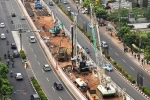Optimising the air network, AP I and II will be merged
This article has been translated by PwC Indonesia as part of our Indonesia Infrastructure News Service. PwC Indonesia has not checked the accuracy of, and accepts no responsibility for the content.
Investor Daily - Optimalkan jaringan udara, AP I dan II akan digabung
6 June 2023
By: Tri Murti
Jakarta - The government is planning to integrate PT Angkasa Pura/AP I (Persero) and PT Angkasa Pura/AP II (Persero) so that the air network can be optimised. State-owned Enterprises (SOE) Deputy Minister II Kartika Wirjoatmodjo said that the integration might not be a merger.
“We see that AP I and AP II are operating in an east-west manner. The concept is all hub and spoke. We want to perform an integration, but it might not be a merger. So, the hub and spoke arrangement can be optimised,” Kartika Wirjoatmodjo, who is familiarly called Tiko, said in Magelang in Central Java on Monday (5/6/2023).
The hub and spoke model connects airlines between two points as it connects passengers to different spokes from the hubs. The hub and spoke transportation network is a cost-effective solution for large networks, and it is also easily manageable and provides great scalability.
Tiko explained that there were currently two superhubs, namely Jakarta and Bali. There are also several other hubs such as Surabaya, Makassar, and Medan with routes that are not nationally and comprehensively organised.
He hopes that the integration that will establish a holding or perform a merger will make the hub and spoke model more effective.
“With the integration that will be implemented by establishing a holding or by performing a merger, the hub and spoke model will be more effective. So, inbound foreign traffic and domestic traffic can be integrated. Previously, the west and the east were separated as if they were under different managements,” Tiko added as quoted by Antara.
Previously, at the start of this year, Minister Erick Thohir mentioned that there would be more corporate actions in the form of consolidations and mergers to merge SOEs with similar business models. It is included in the second phase of the SOE roadmap of 2024-2034.
PT Angkasa Pura I and PT Angkasa Pura II are SOEs that engage in airport management. AP I manages 14 airports in Indonesia’s central and eastern regions, while AP II manages 20 airports that are mostly in western Indonesia.
Regarding performance, PT Angkasa Pura I (Persero) announced that they served 5.3 million passengers in April 2023, which grew 55% from 3.4 million passengers in April 2022. AP I President Director Faik Fahmi explained that the 5.3 million passengers in April 2023 consisted of 4.2 million domestic route passengers and 1.1 million international route passengers.
“We are proud about Angkasa Pura I maintaining a double-digit growth that is above the average growth of the aviation industry. It is a positive trend as the company is continuously putting on their best performance throughout 2023,” AP I President Director Faik Fahmi said recently.
Meanwhile, regarding aircraft movement, AP I served 44,988 movements, which grew 11% from 40,572 movements in 2022.
On the other hand, PT Angkasa Pura II (Persero) has released the number of passenger movements at 20 of its managed airports in May 2023 that reached 7.14 million passengers, which is the highest in the last 3 years since the Covid-19 pandemic in 2020. That number increased by 14% compared to April 2023 and by 18% from the realisation in May 2022.
AP II President Director Muhammad Awaluddin said that passenger movements in May 2023 approached the normal condition in 2019 before the pandemic. In 2019, the number of passenger movements at AP II airports reached around 90.77 million passengers, so the average number of passengers per month was around 7.56 million.
“May 2023 has been the busiest month for AP II since the pandemic hit in 2020. The number of passengers in May 2023 is the highest since the pandemic, and it almost matched the condition in 2019 before the pandemic. Thanks to the great coordination among AP II, airlines, and other stakeholders in managing and accommodating the growing demand amid the recovery period,” Awaluddin said last week.
From 1 to 31 May 2023, all AP I airports cumulatively logged 53,486 flights and 58.88 million tonnes of cargo.
The largest and busiest airport in Indonesia that is managed by AP II, Soekarno-Hatta Airport, recorded that the number of passengers reaches 4.51 million, which consists of 3.42 million domestic route passengers and 1.08 million international route passengers. Meanwhile, at the other 19 AP II airports, the number of passengers cumulatively reaches 2.63 million passengers.
Disagree
Meanwhile, aviation industry observer, practitioner, and consultant Gerry Soejatman disagree about merging AP I and II as both SOEs have their own advantages.
“Since they were separated into AP I and II, both companies have been developing in accordance with their region’s different characteristics. It will create a difference in their corporate culture and in how they see opportunities in the regions that they serve,” he said to Investor Daily on Monday (5/6/2023).
Besides that, Gerry also sees that the merger can hinder the recovery of the aviation industry. Gerry suggests AP I and II airports to be packaged in a strategic partnership or in a public-private partnership (PPP) programme, then an airport holding can be established. Hence, every airport will have space to move to implement competitive and optimum policies in the regions that they serve. “Because every airport is an ambassador and a gate for the region,” Gerry said.
Next Article: Transportation policy: 2024 subsidy surged by 30%



















